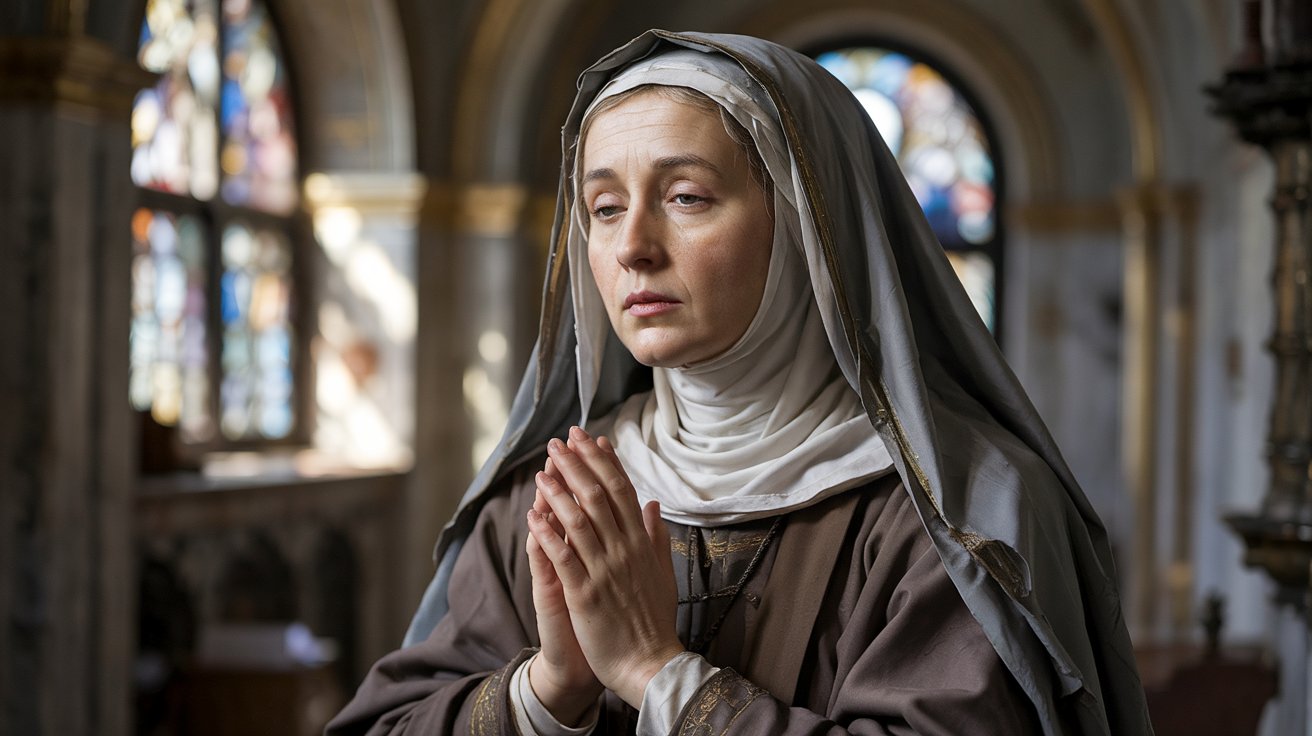The First Catholic Symbol
The Ichthys (ἰχθύς), or fish symbol, is one of the earliest and most significant symbols in Christianity, including the Catholic tradition. While there isn’t a specific recorded date when the Catholic Church officially recognized the Ichthys as a symbol, historical evidence places its use among early Christians as far back as the 2nd century AD.
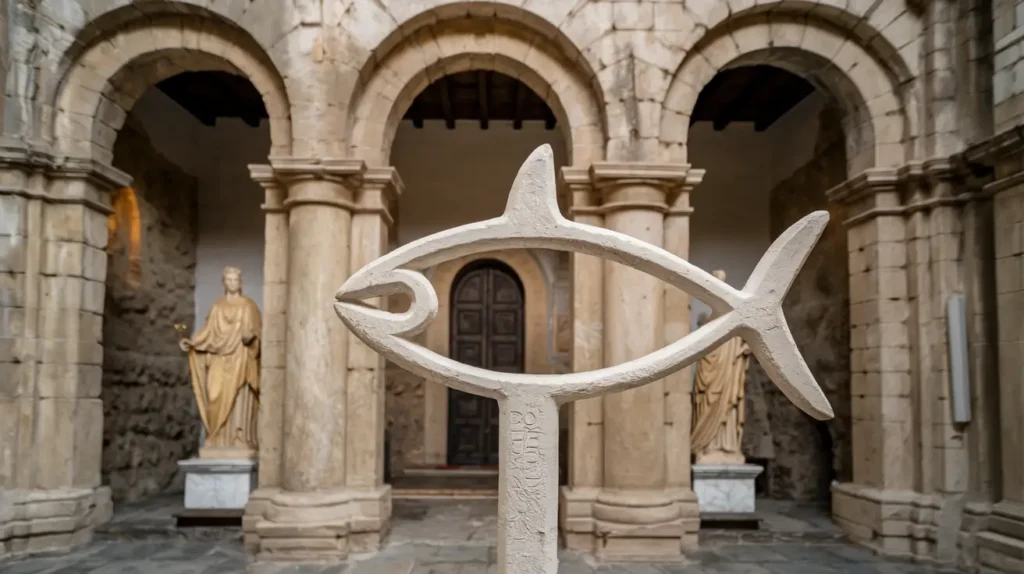
Historical Context:
- Early Adoption (2nd Century AD):
- Catacombs of Rome: Archaeological findings in the Roman catacombs, such as those in Santi Cosma e Damiano and Santi Sebastiano, feature the Ichthys symbol inscribed on walls and tombs dating to the late 1st and early 2nd centuries. These inscriptions often included the Greek acronym ΙΧΘΥΣ (Ichthys), standing for “Ἰησοῦς Χριστός, Θεοῦ Υἱός, Σωτήρ” (“Jesus Christ, Son of God, Savior”).
- Symbolic Significance:
- Secret Identification: During periods of Roman persecution, Christians used the Ichthys as a discreet means of identifying themselves to fellow believers.
- Theological Meaning: Each letter in “Ichthys” serves as an acronym encapsulating core Christian beliefs about Jesus Christ.
Formal Recognition:
While there wasn’t a formal declaration by a specific council or pope marking its recognition, the Ichthys has been an enduring emblem within Catholicism and broader Christianity throughout the centuries.
Evolution Over Time:
The Ichthys gradually became a widely recognized symbol of Christianity beyond just the early, persecuted communities.
As Christianity gained legal status and eventually became the state religion of the Roman Empire under Emperor Constantine in the early 4th century (with the Edict of Milan in 313 AD), the use of Christian symbols like the Ichthys became more open and widespread.
Catholic Tradition:
The Catholic Church, tracing its roots to these early Christian communities, inherited and continued the use of the Ichthys as a symbol of faith.
Chi-Rho (ΧΡ)
Date Established: Early 4th Century AD
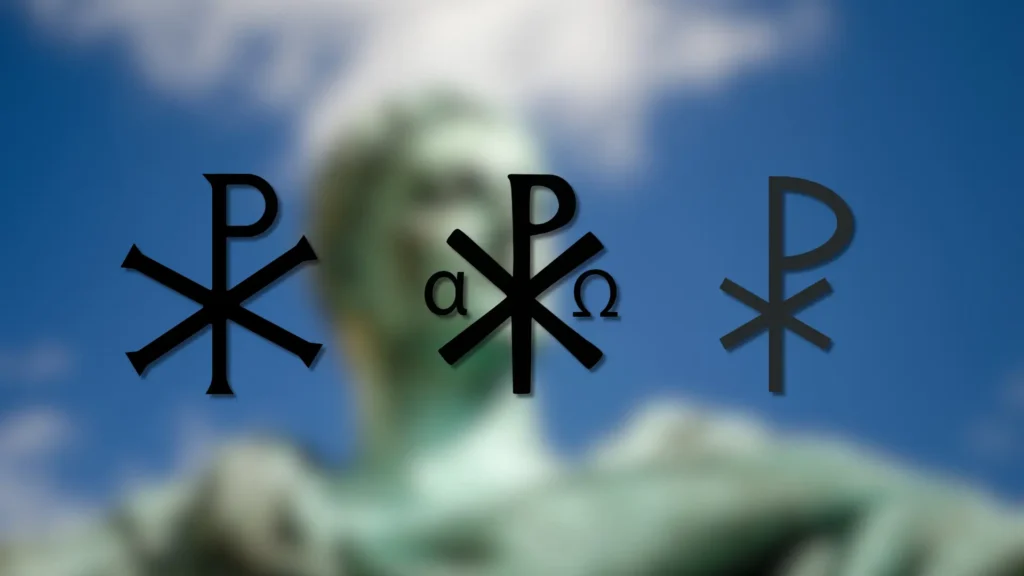
The Chi-Rho is one of the earliest forms of christogram, combining the first two letters (Χ and Ρ) of the Greek word “ΧΡΙΣΤΟΣ” (Christos), meaning “Christ.” Emperor Constantine the Great adopted the Chi-Rho as a military standard after his vision before the Battle of the Milvian Bridge in 312 AD. This symbol became a prominent emblem of Christianity and is widely used in Catholic liturgy and art today.
The Cross
Date Established: Pre-2nd Century AD, Prominent in Early 4th Century

While the cross predates Christianity as a symbol, it was adopted by early Christians as a representation of Jesus Christ’s crucifixion and resurrection. With Constantine’s conversion and the Edict of Milan in 313 AD, the cross became a dominant Christian symbol. It signifies faith, salvation, and the ultimate sacrifice of Jesus, remaining the most recognizable symbol of Catholicism.
The Good Shepherd
Date Established: 3rd Century AD

The Good Shepherd symbol depicts Jesus Christ as a shepherd caring for His flock, illustrating His guidance and protection of believers. This imagery is rooted in the Gospel of John (John 10:11) and became popular in early Christian art and iconography. It emphasizes the pastoral role of Christ and the Church in nurturing and leading the faithful.
The Anchor
Date Established: Early to Mid-4th Century AD

The Anchor became a symbol of hope and steadfastness in early Christianity. It was especially significant during times of persecution, representing the believer’s hope in Christ as the anchor of the soul. The anchor symbol is often combined with the cross, reinforcing the connection between faith and hope.
The Sacred Heart
Date Established: 17th Century
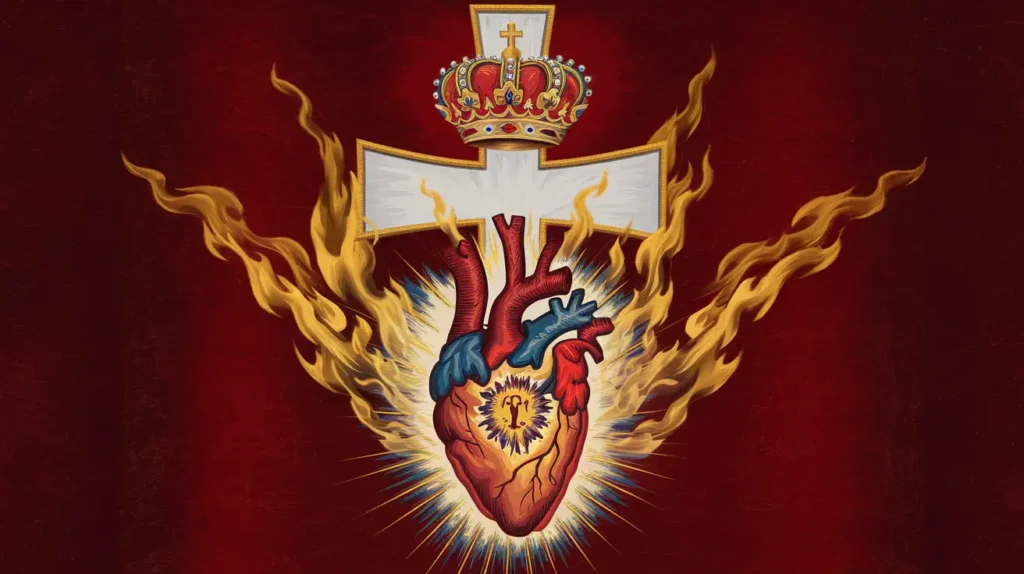
The Sacred Heart of Jesus is a devotional symbol representing Christ’s divine love for humanity. Originating from the visions of Saint Margaret Mary Alacoque in the 1670s, it depicts Jesus with a radiant heart, often surrounded by thorns, symbolizing His suffering and unconditional love. The Sacred Heart has become a central theme in Catholic devotion and art.
The Fleur-de-lis
Date Established: Medieval Period (12th Century)
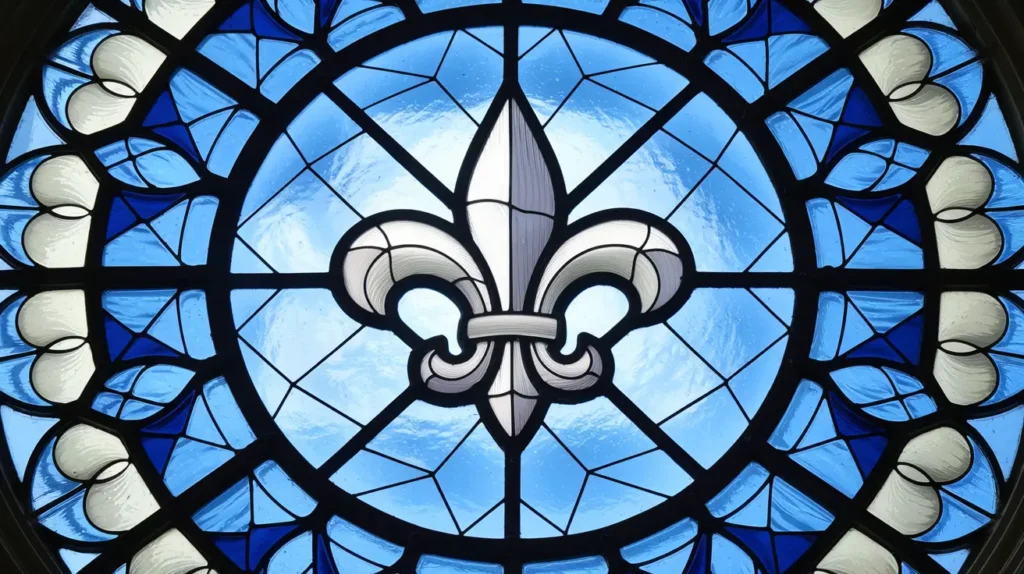
The Fleur-de-lis is a stylized lily flower symbol associated with the Virgin Mary and purity. It became prominent in medieval Catholic iconography, representing the Holy Trinity and the virtues of faith, wisdom, and purity. The fleur-de-lis is also incorporated into various Catholic heraldry and architecture.
The Papal Keys
Date Established: Early Christianity, Formalized by the Middle Ages
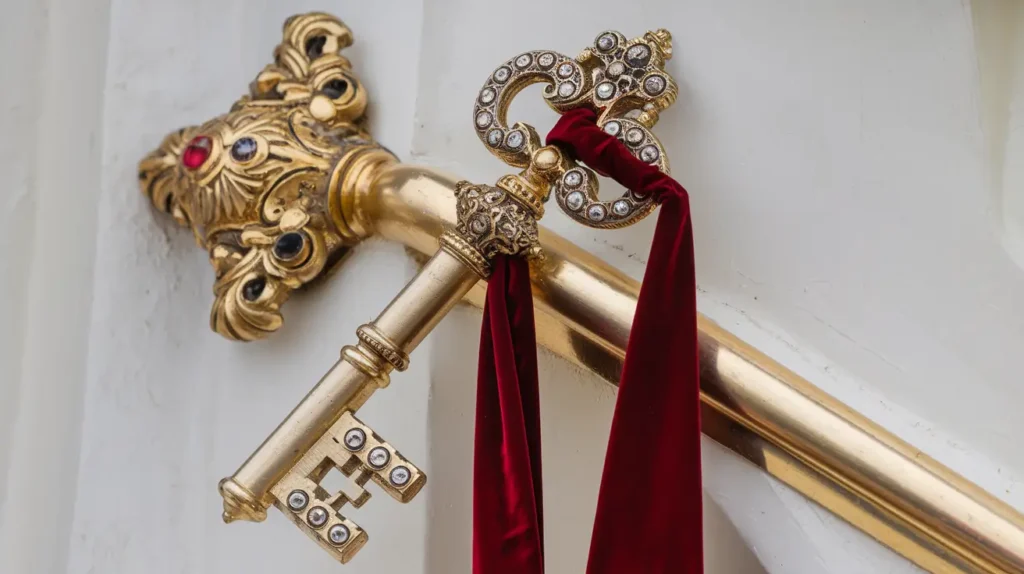
The Papal Keys symbolize the authority of the Pope, derived from the biblical passage where Jesus gives Peter the keys to the Kingdom of Heaven (Matthew 16:19). The crossed keys (one gold and one silver) represent spiritual and earthly power. This emblem is prominently featured in the Vatican’s coat of arms and papal insignia.
The Dove
Date Established: Early Christianity, Prominent in Byzantine Art (5th Century)
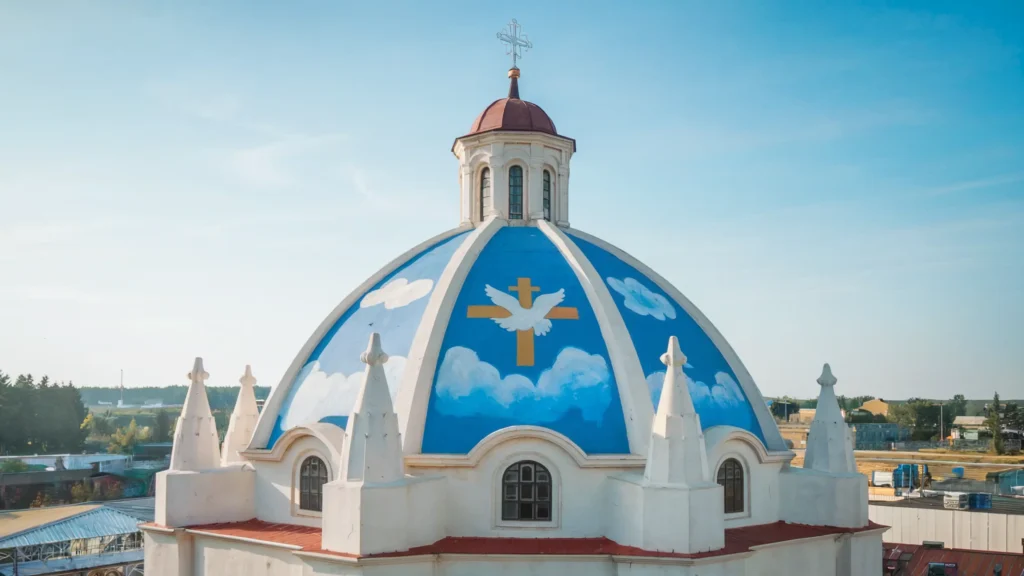
The Dove is a symbol of the Holy Spirit, peace, and purity. It originates from the Gospel accounts of the Holy Spirit descending like a dove during Jesus’ baptism. In Catholic art and liturgy, the dove often appears during baptisms, confirmations, and Pentecost celebrations, representing the presence and action of the Holy Spirit.
The Lamb
Date Established: Early Christianity
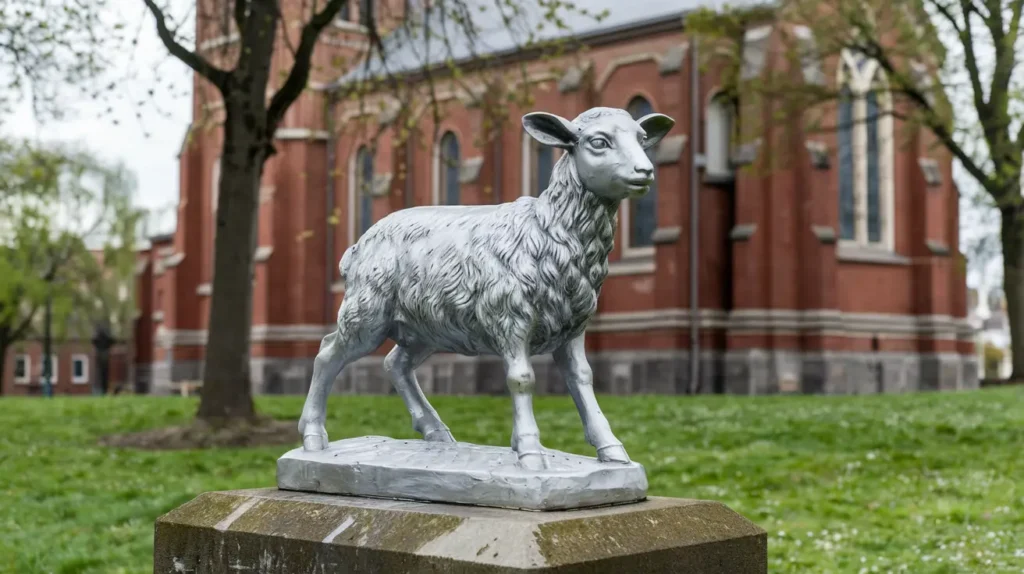
The Lamb symbolizes Jesus Christ as the “Lamb of God” who takes away the sins of the world (John 1:29). This imagery is rooted in Jewish sacrificial traditions and is prominently featured in Catholic liturgy, especially during the Eucharist, where Jesus is commemorated as the sacrificial Lamb.
The Chi-Rho with Alpha and Omega
Date Established: Late Antiquity (4th Century)
This symbol combines the Chi-Rho with the Greek letters Alpha (Α) and Omega (Ω), representing that Christ is the beginning and the end. It underscores the eternal nature of Jesus and His divine authority. The Chi-Rho with Alpha and Omega is frequently used in Catholic liturgical objects, vestments, and ecclesiastical architecture.
The Monogram of Saint Francis
Date Established: 13th Century
The Monogram of Saint Francis consists of the letters “P” and “F” intertwined, representing “Pax” (Peace) and “Fratrum” (of the Brothers). This symbol is associated with Saint Francis of Assisi and embodies his commitment to peace, humility, and simplicity. It is widely used by Franciscan orders and in Catholic art dedicated to Saint Francis.
The Rosary Beads
Date Established: Middle Ages (13th Century)

The Rosary is a string of beads used to count prayers, particularly the Hail Mary, Our Father, and Glory Be. It serves as a tool for meditation and contemplation on the mysteries of Christ’s life and the Virgin Mary’s role. The Rosary is a central devotional practice in Catholicism, symbolizing prayer, reflection, and the intercession of Mary.
The Chi-Rho with Cross and Crown
Date Established: Early Christian Empire (4th Century)
This variation of the Chi-Rho includes a cross and a crown, symbolizing Christ’s victory over death and His sovereignty. It combines elements of martyrdom and triumph, reflecting the early Christian belief in the resurrection and eternal life. This symbol is often found in catacombs, mosaics, and early Christian churches.
The Chi-Rho with Twelve Stars
Date Established: Late Antiquity (4th Century)
This symbol combines the Chi-Rho with twelve stars, representing the twelve apostles and the constellations as symbols of the Church’s universality and divine guidance. It reflects the belief in the Church as a celestial and earthly community guided by Christ. The Chi-Rho with Twelve Stars is used in ecclesiastical art and heraldry.
The Alpha and Omega
Date Established: Early Christianity

The letters Alpha (Α) and Omega (Ω) are the first and last letters of the Greek alphabet, symbolizing that God is the beginning and the end of all things. This emblem underscores the eternal nature of God and His omnipresence. It is frequently used in Catholic liturgy, sacraments, and religious art.
The Chi-Rho with Omega and Alpha
Date Established: Early Christian Empire (4th Century)
A combination of the Chi-Rho with the Alpha and Omega, this symbol reinforces the message of Christ’s eternal presence and divine authority. It is used in various liturgical contexts, including vestments, church decorations, and religious artifacts, symbolizing the comprehensive nature of Christ’s mission and existence.
The Monogram of Christ (ΙΧΘΥΣ with Cross)
Date Established: Early Christianity

This variation of the Ichthys incorporates a cross within the fish symbol, emphasizing the connection between Jesus Christ and the sacrificial nature of His mission. It serves as a more explicit declaration of faith, blending the secretive early Christian identification with the open declaration of Christ’s crucifixion and resurrection.
The Holy Spirit Flames
Date Established: Early Christianity, Prominent in Byzantine Iconography (5th Century)
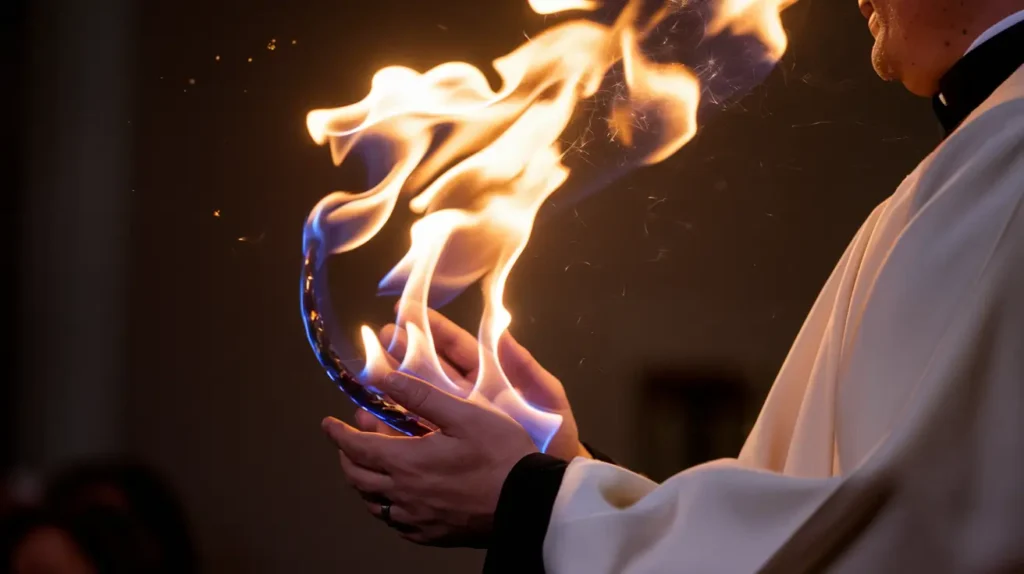
Depictions of flames symbolize the Holy Spirit, inspired by the Pentecost event where the Holy Spirit descended upon the apostles as tongues of fire. This imagery represents divine inspiration, transformation, and the empowering presence of the Holy Spirit in the lives of believers. Flames are commonly featured in Catholic churches, stained glass, and religious artwork.
The Chi-Rho with Rays of Light
Date Established: Late Antiquity (4th Century)
This symbol combines the Chi-Rho with emanating rays of light, signifying Christ as the light of the world and the source of divine illumination. It represents enlightenment, guidance, and the transformative power of faith. The Chi-Rho with Rays of Light is used in ecclesiastical art, liturgical items, and architectural decorations.
The Lamb of God with a Cross
Date Established: Early Christianity

This symbol merges the Lamb of God with a cross, highlighting Jesus Christ’s role as the sacrificial lamb and His crucifixion. It emphasizes redemption, salvation, and the fulfillment of Old Testament prophecies through Christ’s sacrifice. This emblem is prevalent in Catholic liturgy, Eucharistic celebrations, and religious iconography.
The Sacred Heart with Crown of Thorns
Date Established: 17th Century

This depiction of the Sacred Heart includes a crown of thorns, symbolizing Jesus’ suffering and sacrifice for humanity’s salvation. It combines the themes of divine love and human suffering, reinforcing the depth of Christ’s commitment to humanity. The Sacred Heart with Crown of Thorns is a central image in Catholic devotional practices and art.
The Holy Trinity Symbol (Triangle with Circle)
Date Established: Early Christianity, Formalized in the Middle Ages
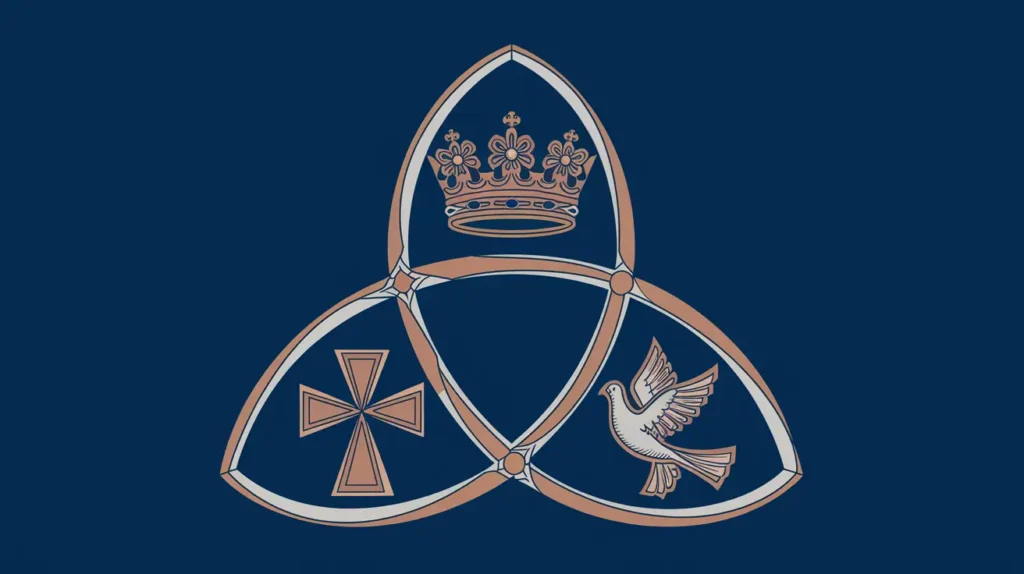
The Holy Trinity symbol often takes the form of a triangle encompassing a circle, representing the Father, Son, and Holy Spirit as three persons in one God. This emblem conveys the mystery of the Trinity and the unity of the divine nature. It is widely used in Catholic liturgy, sacraments, and ecclesiastical architecture.
The Pelican
Date Established: Early Christianity, Prominent in Medieval Art (5th Century Onwards)
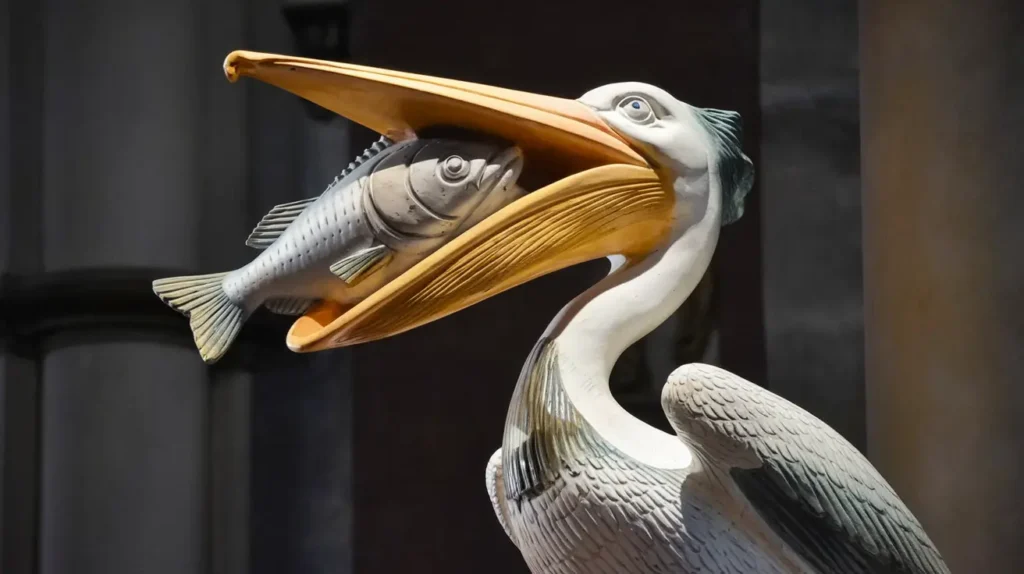
Description and Historical Context:
The pelican is an ancient Christian symbol representing Christ’s sacrifice and the Eucharist. According to medieval legend, a pelican would wound itself to feed its young with its blood, mirroring Jesus Christ’s sacrificial death for humanity. This imagery emphasizes themes of self-sacrifice, redemption, and the sanctity of the Eucharist.
Symbolic Significance:
- Sacrifice and Redemption: Illustrates the extent of Christ’s love and sacrifice for mankind.
- Eucharistic Presence: Represents the sacrificial nature of the Mass and the real presence of Christ in the Eucharist.
Catholic Tradition:
The pelican is frequently depicted in Catholic art, including stained glass windows, frescoes, and illuminated manuscripts. It serves as a reminder of Christ’s ultimate sacrifice and is often used in contexts emphasizing the Eucharist and the Passion of Christ.
St. Michael the Archangel Symbol
Date Established: Early Christianity, Prominent in Medieval Period (5th Century Onwards)

Description and Historical Context:
St. Michael the Archangel is one of the principal angels in Christian theology, often depicted defeating Satan or standing as a protector of the Church. Iconography typically shows him with wings, holding a sword or spear, and sometimes weighing souls.
Symbolic Significance:
- Protector and Defender: Represents the spiritual battle between good and evil, symbolizing divine protection.
- Victory over Satan: Emphasizes the triumph of good over evil and the safeguarding of the faithful.
Catholic Tradition:
St. Michael is venerated as a powerful intercessor and protector. His symbol is commonly found in churches, religious artworks, medals, and jewelry. The Feast of St. Michael, known as Michaelmas, is celebrated on September 29th in the Catholic Church.
St. Benedict Medal
Date Established: Early 17th Century (1514)
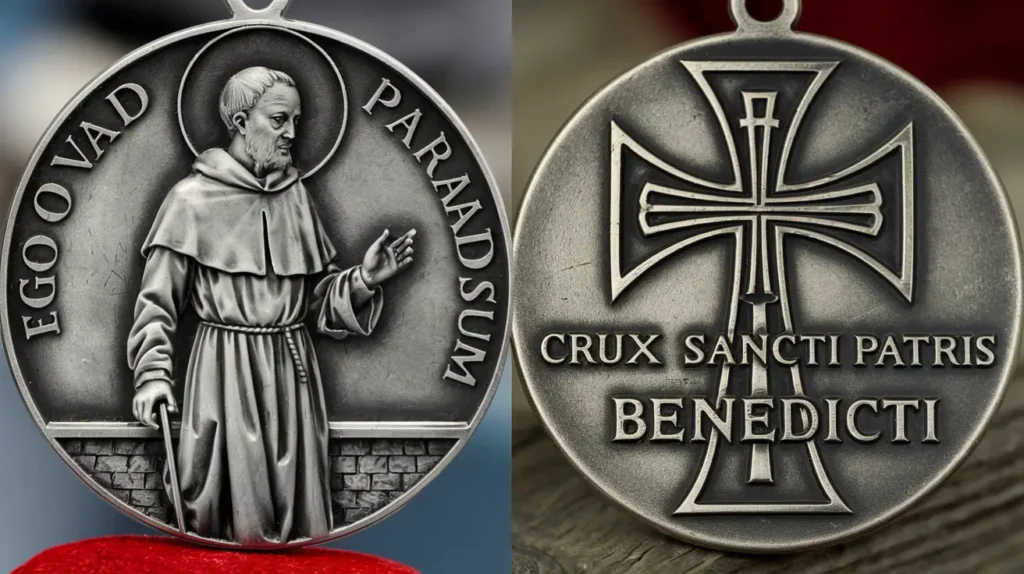
Description and Historical Context:
The St. Benedict Medal is a sacramental medal bearing the image of St. Benedict of Nursia, the patron saint of Europe and students. It features inscriptions and symbols associated with his life and spiritual legacy, including the Cross, the Chi-Rho, and various abbreviations of Latin prayers.
Symbolic Significance:
- Spiritual Protection: Invoked for protection against evil, temptation, and harm.
- Blessing and Sanctification: Used to bless individuals, homes, and objects, invoking divine grace.
Catholic Tradition:
The St. Benedict Medal is widely used in Catholic devotional practices. It is often worn as jewelry, placed in homes, or carried as a talisman. The medal is blessed by priests and is considered a powerful tool for spiritual warfare and protection.
Miraculous Medal
Date Established: 1830s
Description and Historical Context:
The Miraculous Medal originated from the visions of Saint Catherine Labouré, a Marian apparition to a nun in Paris in 1830. The medal features the Blessed Virgin Mary standing on a globe, surrounded by rays of light, with the inscription “O Mary, conceived without sin, pray for us who have recourse to thee.”
Symbolic Significance:
- Marian Devotion: Emphasizes Mary’s purity, intercession, and role in the redemption of humanity.
- Grace and Protection: Believed to confer graces, protection, and blessings upon the wearer.
Catholic Tradition:
The Miraculous Medal is a popular sacramental in the Catholic Church. It is worn as a sign of faith, used in prayer, and displayed in homes and churches. The medal is often associated with miracles and divine intervention, reinforcing trust in Mary’s intercession.
Scapular
Date Established: 16th Century
Description and Historical Context:
The scapular is a devotional garment consisting of two small pieces of cloth connected by strings, worn over the shoulders. It originated with the Carmelite Order and symbolizes the wearer’s commitment to live a Christian life in imitation of Christ.
Symbolic Significance:
- Commitment to Faith: Represents dedication to prayer, charity, and following Christ’s example.
- Spiritual Protection: Believed to offer spiritual benefits and protection to the wearer.
Catholic Tradition:
Various types of scapulars exist, each associated with different religious orders and devotions. The Brown Scapular of Our Lady of Mount Carmel is the most well-known. It is worn by laypeople as a sign of their commitment to live a holy life and seek Mary’s intercession.
The Holy Grail
Date Established: Medieval Period, Prominent in Christian Legend
Description and Historical Context:
The Holy Grail is a legendary object believed to be the cup used by Jesus Christ at the Last Supper and later used to collect His blood during the crucifixion. It symbolizes the quest for divine grace and the pursuit of spiritual perfection.
Symbolic Significance:
- Divine Grace: Represents the ultimate quest for union with God and the reception of divine grace.
- Mystery and Faith: Embodies the mystery of faith and the human desire for spiritual fulfillment.
Catholic Tradition:
While primarily a part of Christian legend and literature, the Holy Grail has been a powerful symbol in Catholic spirituality. It inspires believers to seek deeper spiritual truths and the presence of God in their lives. The Grail is often depicted in art, literature, and religious discussions as a metaphor for the divine mystery.
The Crown of Life
Date Established: Inspired by Biblical Texts, Prominent in Early Christianity
Description and Historical Context:
The Crown of Life is a symbol derived from Revelation 2:10, where believers are promised a crown for their faithfulness and endurance under persecution. It represents the reward awaiting the faithful in heaven.
Symbolic Significance:
- Eternal Reward: Symbolizes the eternal life and rewards promised to those who remain steadfast in their faith.
- Victory Over Trials: Represents triumph over earthly trials and suffering through Christ.
Catholic Tradition:
The Crown of Life is used in Catholic teachings and devotional practices to encourage perseverance and faithfulness. It is often depicted in religious art, especially in contexts emphasizing martyrdom and the hope of eternal life.
St. Patrick’s Cross
Date Established: 5th Century AD
Description and Historical Context:
St. Patrick’s Cross, also known as the Saltire, features a diagonal red cross on a white background. It is associated with St. Patrick, the patron saint of Ireland, and symbolizes his missionary work in converting Ireland to Christianity.
Symbolic Significance:
- Christian Mission: Represents the spread of Christianity and the missionary zeal of St. Patrick.
- Irish Catholic Identity: Serves as a national and religious emblem for Irish Catholics.
Catholic Tradition:
The St. Patrick’s Cross is widely recognized in Ireland and among the Irish diaspora. It is used in religious ceremonies, cultural celebrations, and as a symbol of Irish Catholic heritage. The cross is often incorporated into flags, emblems, and religious iconography associated with St. Patrick.
The Lamb and Flag
Date Established: Early Christianity, Prominent in Medieval Art
Description and Historical Context:
The Lamb and Flag symbol features a lamb carrying a banner or flag, representing Jesus Christ as the sacrificial lamb victorious over sin and death. This imagery combines themes of sacrifice, victory, and proclamation of faith.
Symbolic Significance:
- Victory through Sacrifice: Illustrates Christ’s triumph through His sacrificial death.
- Proclamation of Faith: Symbolizes the spreading of the Gospel and the believer’s commitment to proclaiming Christ’s victory.
Catholic Tradition:
The Lamb and Flag is used in Catholic art and liturgy to emphasize the dual aspects of Christ’s sacrifice and His victorious resurrection. It serves as a reminder of the call to evangelize and live out the faith boldly.
The Holy Spirit as a Dove with Flames
Date Established: Early Christianity, Prominent in Byzantine Iconography (5th Century Onwards)
Description and Historical Context:
While the dove alone is already a symbol of the Holy Spirit, depicting it with flames emphasizes the transformative and empowering aspects of the Holy Spirit. This imagery is inspired by the Pentecost event, where the Holy Spirit descended upon the apostles as tongues of fire.
Symbolic Significance:
- Empowerment and Transformation: Represents the Holy Spirit’s role in empowering believers and transforming lives.
- Divine Presence: Emphasizes the active and dynamic presence of the Holy Spirit in the Church and individual lives.
Catholic Tradition:
This variation is commonly found in Catholic churches, stained glass windows, and religious artwork, particularly in depictions of Pentecost and the descent of the Holy Spirit. It serves as a visual representation of divine inspiration and the active work of the Holy Spirit in the world.
The Holy Lance (Spear of Destiny)
Date Established: Early Christianity, Prominent in Medieval Relics
Description and Historical Context:
The Holy Lance, also known as the Spear of Destiny, is believed to be the spear that pierced the side of Jesus during His crucifixion, as described in the Gospel of John (19:34). It is considered a powerful relic with deep spiritual significance.
Symbolic Significance:
- Suffering and Redemption: Represents the physical suffering of Christ and the redemption achieved through His sacrifice.
- Divine Mystery: Embodies the mystery of the Passion and the profound truths of the faith.
Catholic Tradition:
The Holy Lance is venerated as a sacred relic in the Catholic Church. It is housed in various churches and cathedrals, often associated with pilgrimage and special liturgical celebrations. The lance serves as a tangible connection to the events of the Passion and the sacrificial love of Christ.
The Holy Crown (Corona Mundi)
Date Established: Early Christianity, Prominent in Medieval and Renaissance Art
Description and Historical Context:
The Holy Crown, or Corona Mundi, is a symbol representing Christ as the King of the Universe. It is often depicted as a radiant crown adorned with jewels and celestial motifs, signifying His sovereignty and divine authority.
Symbolic Significance:
- Divine Kingship: Emphasizes Christ’s role as the supreme ruler and King of all creation.
- Eternal Authority: Represents the eternal and unchallengeable authority of God.
Catholic Tradition:
The Holy Crown is featured in various forms of Catholic art, including paintings, sculptures, and liturgical objects. It is used in ceremonies that highlight Christ’s kingship, such as the Feast of Christ the King, reinforcing the belief in His ultimate authority and reign.
The Chi-Rho with Sun Rays
Date Established: Late Antiquity (4th Century)
Description and Historical Context:
This symbol combines the Chi-Rho with emanating sun rays, symbolizing Christ as the “Light of the World.” The rays represent divine illumination and the spreading of Christ’s light to dispel darkness and ignorance.
Symbolic Significance:
- Divine Light: Represents Christ’s role in bringing spiritual enlightenment and guidance.
- Hope and Renewal: Emphasizes the transformative power of faith to bring hope and renewal to believers.
Catholic Tradition:
The Chi-Rho with Sun Rays is utilized in Catholic liturgy, architecture, and religious art to convey the message of Christ’s light and presence. It serves as a reminder of the ongoing mission to spread the Gospel and illuminate the world with divine truth.
The Holy Spirit as a Fire
Date Established: Early Christianity, Prominent in Pentecost Imagery
Description and Historical Context:
Depicting the Holy Spirit as tongues of fire emphasizes the Spirit’s dynamic and purifying presence. This imagery is drawn from the Pentecost narrative, where the Holy Spirit descended upon the apostles in the form of flames.
Symbolic Significance:
- Purification and Renewal: Represents the Holy Spirit’s role in purifying hearts and renewing faith.
- Energy and Passion: Symbolizes the divine energy that fuels the mission and passion of the Church.
Catholic Tradition:
Flames symbolizing the Holy Spirit are commonly found in Catholic churches, particularly in depictions of Pentecost. They are used in liturgical celebrations, stained glass windows, and religious artwork to convey the vibrant and transformative presence of the Holy Spirit.
The Sacred Vessel (Chalice and Host)
Date Established: Early Christianity, Central to the Eucharist
Description and Historical Context:
The chalice and host are the primary symbols of the Eucharist, representing the body and blood of Christ. The chalice holds the wine, and the host is the consecrated bread, both essential elements of the Mass.
Symbolic Significance:
- Sacrifice and Communion: Symbolize the sacrificial offering of Christ and the communion of believers with Him.
- Mystery of Faith: Represent the mystery of transubstantiation, where bread and wine become the body and blood of Christ.
Catholic Tradition:
The chalice and host are central to Catholic liturgy and are prominently displayed on the altar during Mass. They are also depicted in religious art, vestments, and liturgical objects, underscoring their significance in Catholic worship and sacramental theology.
The St. Francis of Assisi Symbol (Ternary Cross)
Date Established: 13th Century
Description and Historical Context:
The ternary cross, associated with St. Francis of Assisi, features three equal-length arms, often symbolizing the Holy Trinity or the three vows of Franciscan life: poverty, chastity, and obedience. This simple yet profound design reflects St. Francis’s commitment to living out his faith in humility and service.
Symbolic Significance:
- Trinitarian Faith: Represents the unity and equality of the Father, Son, and Holy Spirit.
- Franciscan Values: Embodies the core values of poverty, chastity, and obedience upheld by the Franciscan Order.
Catholic Tradition:
The ternary cross is widely used by Franciscan communities and is often seen in their churches, habit insignia, and devotional items. It serves as a symbol of their dedication to following Christ’s example through simplicity, humility, and service to others.
The Holy Face (Sacred Veil)
Date Established: Early Christianity, Prominent in Catholic Devotion (16th Century with the Veil of Veronica)
Description and Historical Context:
The Holy Face, also known as the Sacred Veil, is a devotional image believed to depict the face of Jesus as seen by Saint Veronica during the Via Dolorosa on the way to His crucifixion. According to tradition, Saint Veronica wiped Jesus’ face, and an image miraculously appeared on her veil.
Symbolic Significance:
- Compassion and Mercy: Represents Jesus’ compassion and willingness to suffer for humanity.
- Veneration of Christ’s Suffering: Emphasizes the humanity of Jesus and His suffering during the Passion.
Catholic Tradition:
The Holy Face is venerated in Catholic devotion, particularly through the Feast of the Holy Face of Jesus, celebrated on the Sunday within the Octave of the Sacred Heart. The image is often displayed in churches, homes, and personal prayer spaces, serving as a focal point for meditation on Christ’s suffering and love.
The Sheathed Sword
Date Established: Early Christianity, Associated with Saints and Martyrs
Description and Historical Context:
The sheathed sword is a symbol representing peace and the authority of the Church. It is often associated with archangels like St. Michael or saints who wielded swords as symbols of spiritual warfare and defense of the faith.
Symbolic Significance:
- Peace and Authority: Represents the Church’s authority to maintain peace and defend the faith.
- Spiritual Warfare: Symbolizes the struggle against evil and the protection of the faithful.
Catholic Tradition:
The sheathed sword is used in Catholic heraldry, processions, and artwork. It serves as a reminder of the Church’s mission to uphold justice and combat spiritual adversities. In some contexts, it is associated with the Archangel Michael or patron saints who are depicted with swords.
The Scallop Shell
Date Established: Medieval Period, Prominent in Pilgrimage Symbolism
Description and Historical Context:
The scallop shell is a symbol of pilgrimage, particularly associated with the Camino de Santiago, a major Catholic pilgrimage route in Spain leading to the shrine of the apostle Saint James the Great. Pilgrims often carry scallop shells as a sign of their journey.
Symbolic Significance:
- Pilgrimage and Journey of Faith: Represents the physical and spiritual journey undertaken by pilgrims seeking spiritual growth.
- Hospitality and Safe Travel: Symbolizes the hospitality offered to pilgrims and the wish for safe travels.
Catholic Tradition:
The scallop shell is used as a symbol of pilgrimage in Catholic art, signage for pilgrimage routes, and devotional items. It is often worn by pilgrims, depicted in religious artwork, and used in liturgical contexts to honor the tradition of pilgrimage as a form of spiritual exercise.
The Bible
Date Established: Early Christianity, Central to the Faith since Apostolic Times
Description and Historical Context:
The Bible is the sacred scripture of Christianity, encompassing the Old and New Testaments. It is the foundational text for Catholic doctrine, teachings, and liturgy, believed to be inspired by God.
Symbolic Significance:
- Divine Revelation: Represents God’s revelation to humanity and the source of divine truth.
- Guidance and Wisdom: Symbolizes the guidance the faithful receive for living a holy and moral life.
Catholic Tradition:
The Bible is central to Catholic worship, studied in personal and communal settings, and used in liturgical readings during Mass. It is often depicted in religious art, carried by saints, and honored as the Word of God, essential for understanding and living out the faith.
These additional symbols enrich the tapestry of Catholic iconography, each carrying deep theological meanings and historical significance. They continue to inspire and guide the faithful in their spiritual journey.



